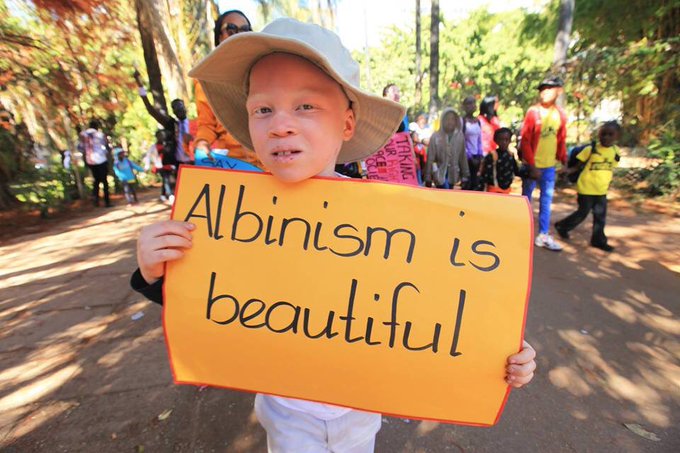Albinism Awareness Month
September is Albinism awareness month in South Africa!

What is albinism?
Albinism is a rare, non-contagious, genetically inherited difference present at birth. In almost all types of albinism, both parents must carry the gene for it to be passed on, even if they do not have albinism themselves. The condition is found in both sexes regardless of ethnicity and in all countries of the world. Albinism results in a lack of pigmentation (melanin) in the hair, skin and eyes, causing vulnerability to the sun and bright light. As a result, almost all people with albinism are visually impaired and are prone to developing skin cancer. There is no cure for the absence of melanin that is central to albinism.
While numbers vary, it is estimated that in North America and Europe 1 in every 17,000 to 20,000 people have some form of albinism. The condition is much more prevalent in sub-Saharan Africa, with estimates of 1 in 1,400 people being affected in Tanzania and prevalence as high as 1 in 1,000 reported for select populations in Zimbabwe and for other specific ethnic groups in Southern Africa.
Health challenges of people living with albinism
The lack of melanin means persons with albinism are highly vulnerable to developing skin cancer. In some countries, a majority of persons with albinism die from skin cancer between 30 and 40 years of age. Skin cancer is highly preventable when persons with albinism enjoy their right to health. This includes access to regular health checks, sunscreen, sunglasses and sun-protective clothing. In a significant number of countries, these life-saving means are unavailable or inaccessible to them. Consequently, in the realm of development measures, persons with albinism have been and are among those “left furthest behind.” Therefore, they ought to be targeted for human rights interventions in the manner envisioned by the Sustainable Development Goals.
Due to a lack of melanin in the skin and eyes, persons with albinism often have permanent visual impairment. They also face discrimination due to their skin colour; as such, they are often subject to multiple and intersecting discrimination on the grounds of both disability and colour.
People with albinism and human rights
People with albinism face multiple forms of discrimination worldwide. Albinism is still profoundly misunderstood, socially and medically. The physical appearance of persons with albinism is often the object of erroneous beliefs and myths influenced by superstition, which foster their marginalization and social exclusion. This leads to various forms of stigma and discrimination.
In some communities, erroneous beliefs and myths, heavily influenced by superstition, put the security and lives of persons with albinism at constant risk. These beliefs and myths are centuries old and are present in cultural attitudes and practices around the world.
United Nations Independent Expert on the enjoyment of human rights by persons with albinism
Violence and discrimination against persons with albinism
The United Nations Human Rights Council adopted a resolution in 2013 (A/HRC/RES/23/13) calling for the prevention of attacks and discrimination against persons with albinism. Moreover, in response to the call from civil society organizations advocating to consider persons with albinism as a specific group with particular needs that require special attention, the Council created the mandate of the Independent Expert on the enjoyment of human rights by persons with albinism. In June 2015, the Human Rights Council appointed Ms. Ikponwosa Ero as the first Independent Expert on the enjoyment of human rights by persons with albinism.
While it has been reported that persons with albinism globally face discrimination and stigma, information on cases of physical attacks against persons with albinism is mainly available from countries in Africa.
Persons with albinism face more severe forms of discrimination and violence in those regions. A greater degree of contrast in pigmentation often gives rise to a greater degree of discrimination. That appears to be the case in some sub-Saharan African countries where albinism is shrouded in myth and dangerous and erroneous beliefs. The figures on violations against persons with albinism are telling. There have been hundreds of cases of attacks and killings of persons with albinism reported in 28 countries in Sub-Saharan Africa in the past decade. The attacks have several root causes including ignorance, longstanding stigma, poverty and most abhorrently, harmful practices emanating from manifestation of beliefs in witchcraft. The alarming reality is that these horrendous practices continue today.
The manner in which discrimination faced by persons with albinism manifests itself, and its severity, vary from region to region. In the western world, including North America, Europe and Australia, discrimination often consists of name-calling, persistent teasing and bullying of children with albinism. Little information is available from other regions such as Asia, South America and the Pacific etc. However, some reports indicate that in some Asian countries, children with albinism face abandonment and rejection by their families.
Source: https://www.un.org/en/observances/albinism-day












